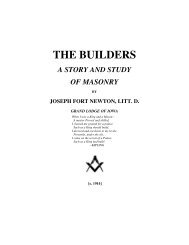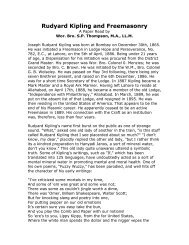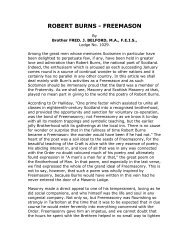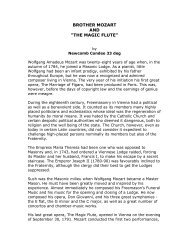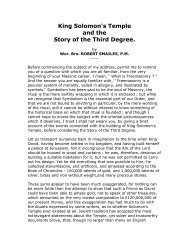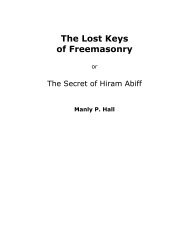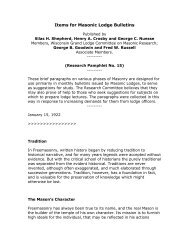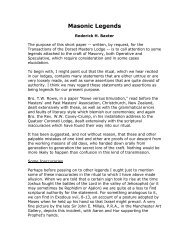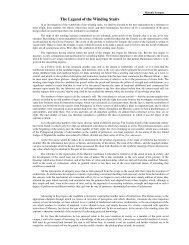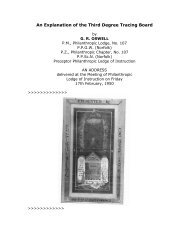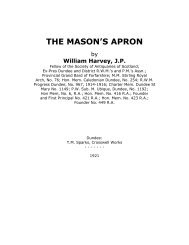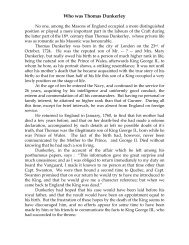Through the Key Hole - RoseCroix.org.au
Through the Key Hole - RoseCroix.org.au
Through the Key Hole - RoseCroix.org.au
You also want an ePaper? Increase the reach of your titles
YUMPU automatically turns print PDFs into web optimized ePapers that Google loves.
16<br />
THE STEINMETZEN<br />
The Pocket History of Freemasonry—Pick & Knight<br />
The <strong>the</strong>ory that our fraternity derived from <strong>the</strong> Steinmetzen, or<br />
stonecutters, of Germany became very popular about 150 years<br />
ago following <strong>the</strong> publication in 1848 of <strong>the</strong> writings of Fallou who,<br />
However, failed to submit any evidence in support of his claim.<br />
His lead was followed uncritically by later writers, including several<br />
of much greater eminence. The Abbot Wilhelm, of Hirsch<strong>au</strong>, is<br />
said to have introduced an institution of lay bro<strong>the</strong>rs but examination<br />
of <strong>the</strong> records shows that <strong>the</strong>se were not connected with <strong>the</strong><br />
building trades.<br />
Ano<strong>the</strong>r claim, like that of <strong>the</strong> Comacines, is that <strong>the</strong> Steinmetzen<br />
were established by papal bulls but <strong>the</strong>se have never been traced,<br />
As in o<strong>the</strong>r countries, Lodges were set up in connection with <strong>the</strong><br />
building of <strong>the</strong> great ca<strong>the</strong>drals and <strong>the</strong>ir rules and customs tend to<br />
follow a common pattern. It must be remembered that for several<br />
reasons <strong>the</strong>re was a constant interchange of staff and <strong>the</strong>re would<br />
be a tendency for <strong>the</strong> best ideas evolved in one place quickly to<br />
spread to o<strong>the</strong>rs.<br />
The earliest known text of <strong>the</strong>ir rules was drawn up at Regensburg<br />
in 1459 and <strong>the</strong> T<strong>org</strong><strong>au</strong> Statutes in 1462 record <strong>the</strong> acceptance by<br />
masters ,from several places, of <strong>the</strong> ordinances previously drawn<br />
up. These ordinances were confirmed by imperial <strong>au</strong>thority in 1498<br />
and again in 1563. Translations may be found in Gould’s “History<br />
of Freemasonry” but we may here mention briefly that though some<br />
of <strong>the</strong>ir provisions are found in <strong>the</strong> Old Charges of England, <strong>the</strong>y do<br />
not in <strong>the</strong> main follow those documents.<br />
The Apprentice, when declared free, was required to enter into an<br />
obligation among o<strong>the</strong>r things not unlawfully to communicate <strong>the</strong><br />
mason’s greeting and grip and not to alter without permission <strong>the</strong><br />
mark conferred on him.<br />
160<br />
3. By an extraordinary coincidence, <strong>the</strong> badge used by <strong>the</strong> Nazis<br />
For <strong>the</strong> collection made in March 1938, happened to be <strong>the</strong><br />
very f<strong>org</strong>et-me-not pin chosen by <strong>the</strong> Freemasons in 1926<br />
and it was made by <strong>the</strong> same factory in Selb. It is important to<br />
note that to wear a badge, pin or emblem that had not origin<br />
originated in <strong>the</strong> Nazi party was an offence under <strong>the</strong> Nazi<br />
regime.<br />
4. When Grand Master Vogel installed a new lodge at Selb in<br />
1948, he remembered <strong>the</strong> story of <strong>the</strong> pin. Since <strong>the</strong> factory<br />
and <strong>the</strong> mould still existed he let a large quantity be made<br />
anew and distributed <strong>the</strong>m as a token of friendship whenever<br />
he made official visits abroad, especially in <strong>the</strong> USA.<br />
5. This explains why <strong>the</strong> blue-f<strong>org</strong>et-me-not turned out to be<br />
regarded as an official German Masonic emblem after <strong>the</strong><br />
war.<br />
6. This also explains why, when American Masons later founded<br />
military lodges in Germany, some of <strong>the</strong>m chose <strong>the</strong> flower<br />
as a lodge’s name.<br />
THE TAU PAPER BY KLAUS MÜLLER AND THE ENGLISH<br />
DOCUMENT<br />
In Volume II (1995) of TAU <strong>the</strong> biannual publication of <strong>the</strong> German<br />
Quatuor Coronati lodge of Research, <strong>the</strong>re is a short paper written<br />
by <strong>the</strong> <strong>the</strong> Wor. Master of <strong>the</strong> lodge, Bro. Kl<strong>au</strong>s Müller stating that<br />
each newly admitted Mason within <strong>the</strong> Grand Lodge of British Freemasons<br />
in Germany received a f<strong>org</strong>et-me-not pin whereas <strong>the</strong><br />
American Canadian Grand lodge gave such a pin to Master Masons<br />
when <strong>the</strong>y were raised. The paper included <strong>the</strong> facsimile of a<br />
text “ in most lodges <strong>the</strong> F<strong>org</strong>et-me-Not is presented to new Master<br />
Masons, at which time its history is briefly explained” Kl<strong>au</strong>s Müller<br />
did not specify which Masonic body issued that text, but he did introduce<br />
it as “The English Text”.<br />
Harold Davidson, Librarian of <strong>the</strong> Philale<strong>the</strong>s Society, was asked to<br />
comment and send any relevant documentation he might have. Part<br />
of this multitude of submissions included a paper which contained<br />
<strong>the</strong> following:



